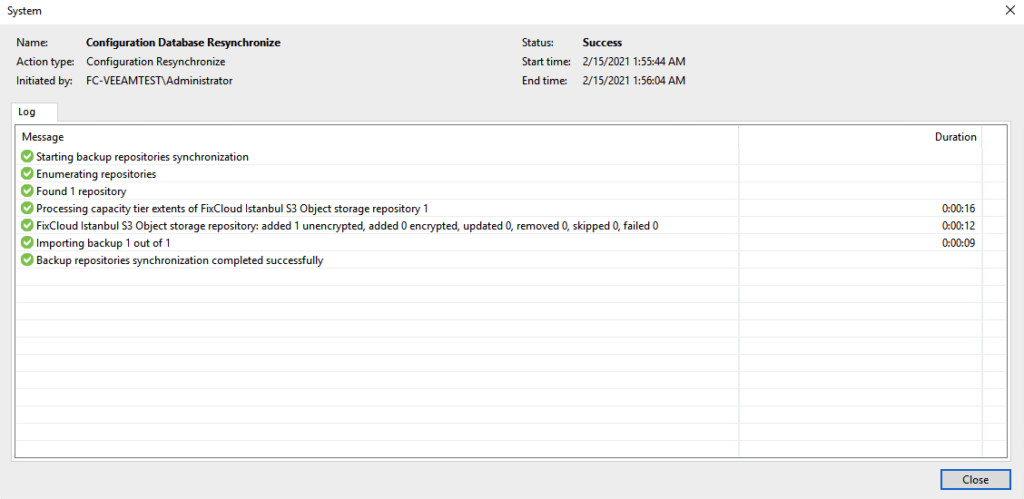Hello,
In this article, we will take a look at the scenario of Restore via S3 Compatible Object Storage.
Part 1 - Controlling Our Cloud Backups
We have successfully backed up our local.
Thanks to the Scale-out Backup Repository capability, we have successfully sent the backup we have taken to our local to S3 Compatible Object Storage, which we added in the first document.
We check the Backup status we have taken for the test environment from the Backup> Disk section on the left, the point we have to pay attention to in the Repository section is included in the 'Scale-out Backup Repository'.
In the Home Menu, we enter the Backup> Infrastructure menu at the bottom left.We can view the size of our backup file that we have sent to the S3 Compatible Object Storage storage pool we have
added in the Backup Repositories area.

Part 2 - Restoring from S3 Compatible Object Storage
We will restore the backup that we sent to S3 as read-only using the Immutable feature to our environment, first we enter the Home menu and under the Backups section on the left, we see the following options.

Disk > It appears as an area where we can control the backups we have taken to our local.
Object Storage > It appears as an area where we can control the backups we have sent to the S3 compatible object storage area.
We have understood the main difference between the two, imagine a scenario where your local backups are unavailable as a result of a data breach and you lose. In such a severe case, we will perform a Restore VM operation from the backups we have sent to S3 Object Compatible Storage.
We have installed a new Veeam Backup & Replication in our environment, we introduced our Virtualization / Physical environments under Managed Servers (VMware, Hyper -V or Psyhical Server), now we are entering the Backup Repositoeries are, and we will import the backups we previously sent to Object Storage with the Import backups option, right click on our Object Storage area and click Import Backups on the window that opens.

We see the following warning (Import of backup metadata from Object Storage may take a long time depending on the number of machines and restore points.) We proceed by saying Yes.

We have successfully completed the Import process.

In the Summary section, it is displayed that the Import Backups process is ready, we complete the wizard with the Finish option.

Configuration wizard has finished importing existing backups, we close the wizard with the Close option.

Under the Backups menu, we are viewing that the Object Storage (Imported) field has been created, previously there was no 'Imported' statement in this field.

Job Name: Daily Backup Job - VMware vSphere and VM: Test (We see that there are 2 return points of the virtual machine.)

Our backups are ready for the restore process, we will directly restore our machine to our current environment again, we proceed with the Restore entire VM option.
Basically because we know the Entire VM stages, I do not add these stages. As a footnote, I share the 'Restore Mode' features with you as below.
In the restore mode section, choose 'Restore to the original location' if you want to restore the VM with its initial settings and to its original location.
If you want to restore to a new host or with different settings (eg VM host, network settings, format of disks to be restored), select 'Restore to a new location, or different settings'.
Select the Restore VM tags check box if you want to restore the tags assigned to the original VM and assign them to the restored VM.
Veeam will restore the VM with its original tags if the following conditions are met.
- The VM is restored to the host it was in before.
- The VM tag can be used in the source of the vCenter server.

On the Restoring VM screen, we can view the steps that take place during the restoration of the relevant virtual machine.
Restoring from part appears as Object Storage Repository. Since the size of our virtual machine on the Repository side is 8.2 GB, 8.2 GB of data has been downloaded from S3 Object Compatible Storage (Capacity Tier).

In the Scale-Out Backup Repository, our storage pools are configured as follows by default.
Peformance Tier: It appears as your Local Storage space.
Capacity Tier: It appears as your Object Storage space.
If we want to add S3 Object Compatible Storage to our environment again, we enter the Backup Infrastructure menu, right click the S3 Object Compatible Storage Storage that we have added in the Backup Repositoeries section, select Detach repository, remove S3 Object Compatible Storage from our environment, and Scale-out that we created in the first section It will be enough to rebuild the repositoeries and configure it to keep our up-to-date backups.

IMPORTANT NOTE: If you want to perform a return test from Object Storage in our test environment, or in cases where local backups are unavailable as a result of a cyber attack, you can enter the Backup Infrastructure menu, right click the Local Backup Repository storage pool in the Scale-out Repositories area and select 'Maintenance mode'. You can return your S3 Cloud Backups with priority by marking our storage space to maintenance mode.
 In this scenario, since Local Backup Repository will be in maintenance mode (inaccessible), all data will be downloaded from Object Storage and returned.
In this scenario, since Local Backup Repository will be in maintenance mode (inaccessible), all data will be downloaded from Object Storage and returned.



